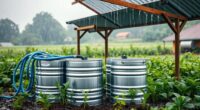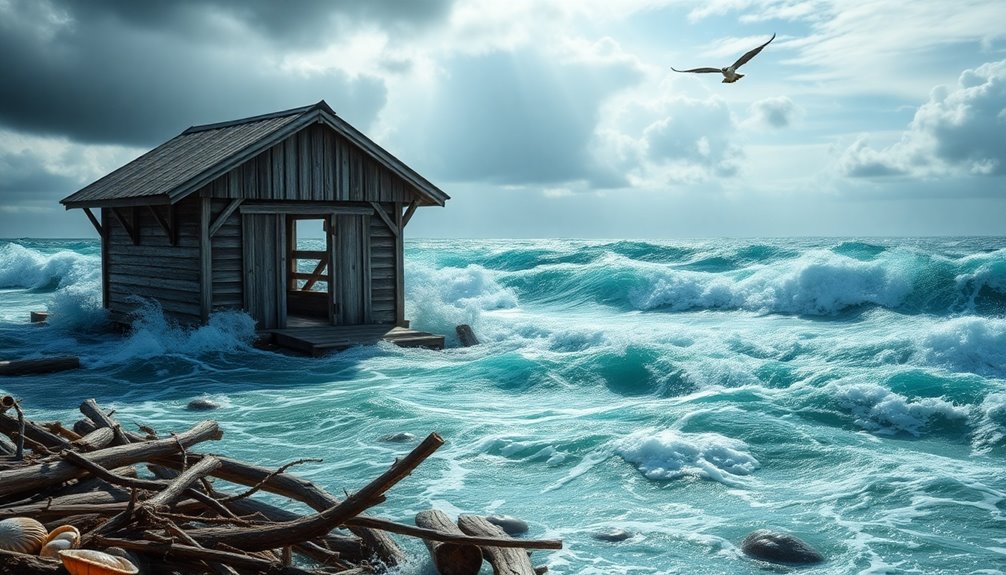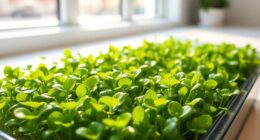To find water in the wilderness, look for natural sources like streams, ponds, or vegetation that indicates moisture, such as hydrophytes. Follow animal trails, which often lead to water, and observe bird activity for signs of nearby sources. Keep an eye on weather patterns too; rain and dew can provide hydration. You can also melt snow or set up solar stills for purification. There's plenty more to uncover about locating and conserving water in survival situations.
Key Takeaways
- Look for natural water sources such as streams, rivers, lakes, and ponds, especially in valley floors or shaded rocky areas.
- Observe vegetation; hydrophytes and dense plant life indicate nearby water sources, while specific plants like sacaton can guide you.
- Follow animal trails, as they often lead to water sources and are more active during dawn or dusk.
- Pay attention to bird behavior; increased bird activity signals proximity to water, and their flight patterns can guide you.
- Collect rainwater using tarps and create a purification system through boiling, filtration, or chemical tablets for safe drinking.
Understanding Topography for Water Sources
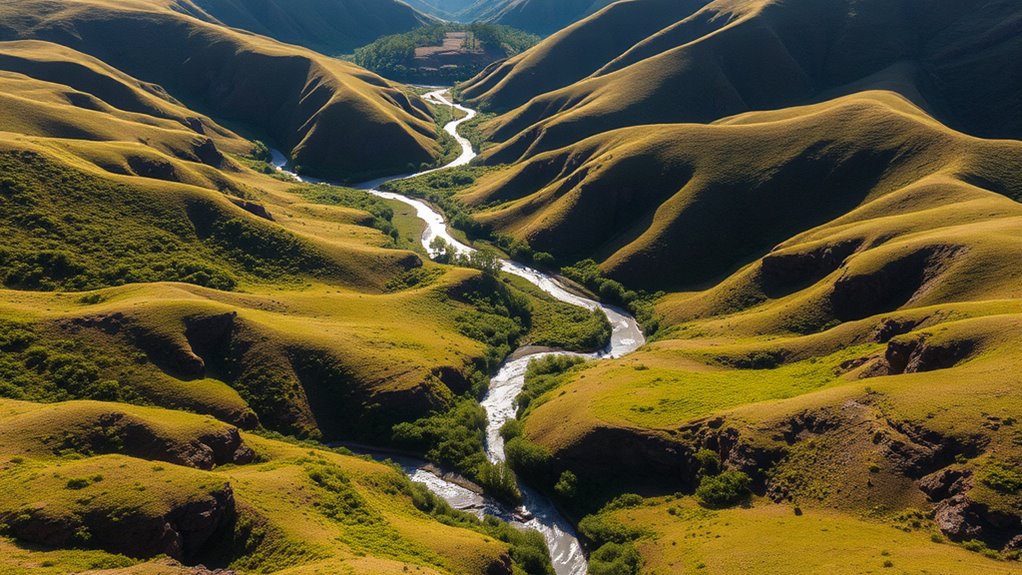
When you're out in the wilderness, understanding topography can significantly increase your chances of finding water.
Start by looking for valley floors, as water naturally collects in these low-lying areas. Mountain streams are often nearby and less likely to be contaminated, making them prime spots to check.
Keep an eye out for rocky outcrops; water may seep down their sides, especially in shaded regions. Natural depressions can also hold water, so consider digging there.
Don't overlook caves near water sources; they can provide shelter and may contain water, particularly if moss is present.
Recognizing Vegetation Indicators
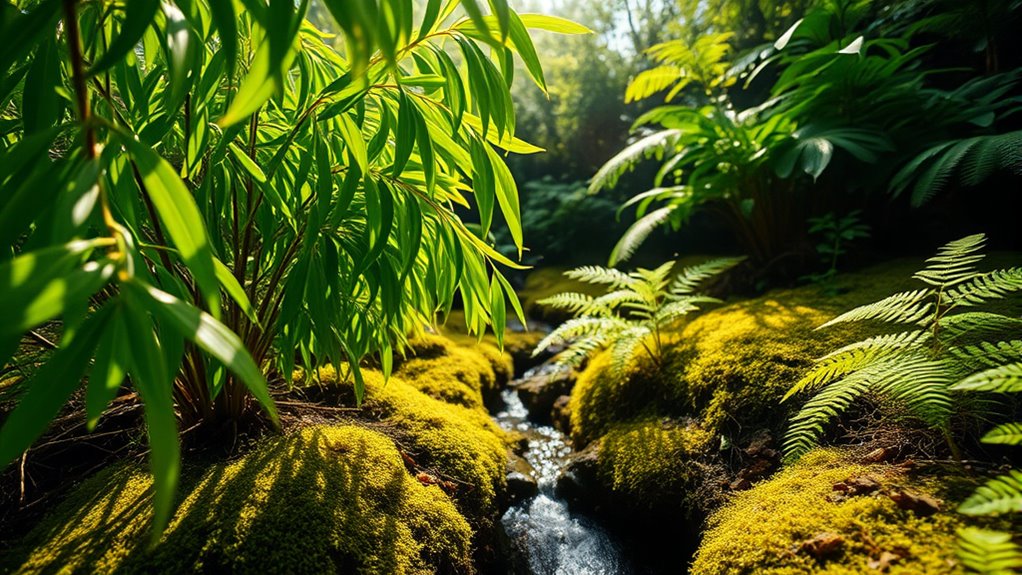
Recognizing vegetation indicators can be a game-changer in your search for water in the wilderness. Look for hydrophytes, as they thrive in wet soil or water, signaling nearby sources.
Plants like greasewood and salt grass have deep roots that access groundwater, hinting at moisture beneath the surface. Dense vegetation often indicates water availability, while green, vibrant plants suggest a reliable source is close by.
Greasewood and salt grass reveal hidden groundwater, while lush vegetation signals nearby water sources for survival in the wild.
Pay attention to shifts in plant communities; they can reveal changes in water conditions. Remember, alfalfa in arid areas can point to groundwater, and the presence of specific species like sacaton can guide you to hidden water supplies.
Mastering these indicators is essential for survival in the wild.
Tracking Animal Trails to Water

Tracking animal trails to water can be one of the most effective strategies for finding hydration in the wilderness. Animals need water, so they often travel to sources at dawn or dusk. By following their well-worn paths, you can uncover routes to water.
Look for distinct tracks in soft substrates like mud, which can reveal the species and direction of travel. Observe where animal activity peaks—these spots typically indicate nearby water. Use a tracking stick to gauge stride and predict where the next tracks might lead.
Consistent trails suggest reliable access to hydration. By interpreting animal signs, you can piece together their behavior and identify potential water sources, crucial for your survival in the wild.
Observing Bird Behavior for Water Location
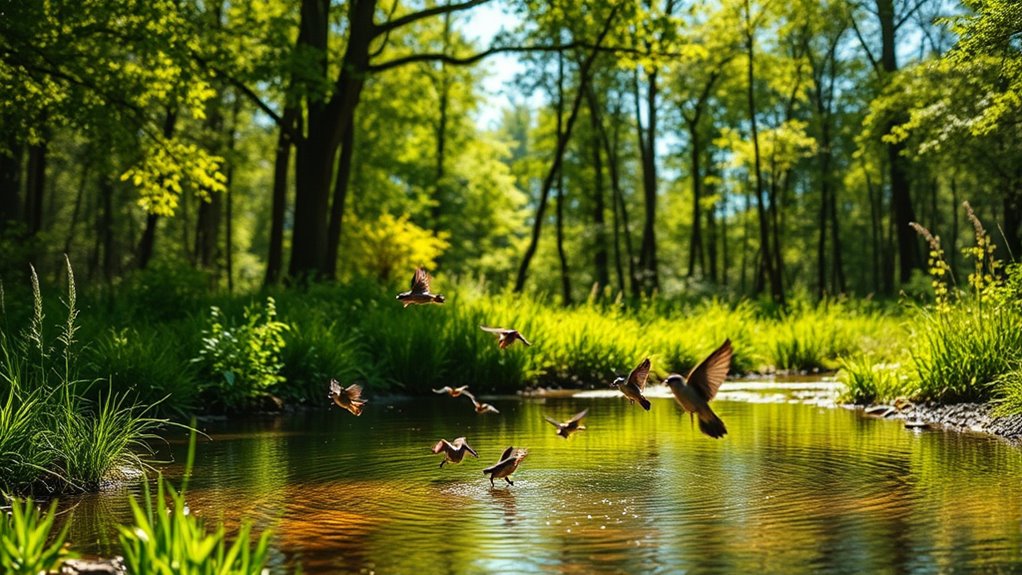
How can you use bird behavior to pinpoint water sources in the wilderness? Observing birds is a great way to find water. Birds need water for drinking and bathing, so their presence can indicate nearby sources.
Pay attention to the type of birds you see; for instance, songbirds prefer shallow pools, while dabbling ducks favor vegetated areas. Increased bird activity, especially during early morning and late afternoon, signals a reliable water source.
Look for flight patterns, as birds often fly directly to water, and listen for their calls. Following bird trails can lead you to hidden spots.
If you notice a lack of bird activity, it might suggest an absence of water or poor habitat quality.
Utilizing Sky Observations for Moisture Detection
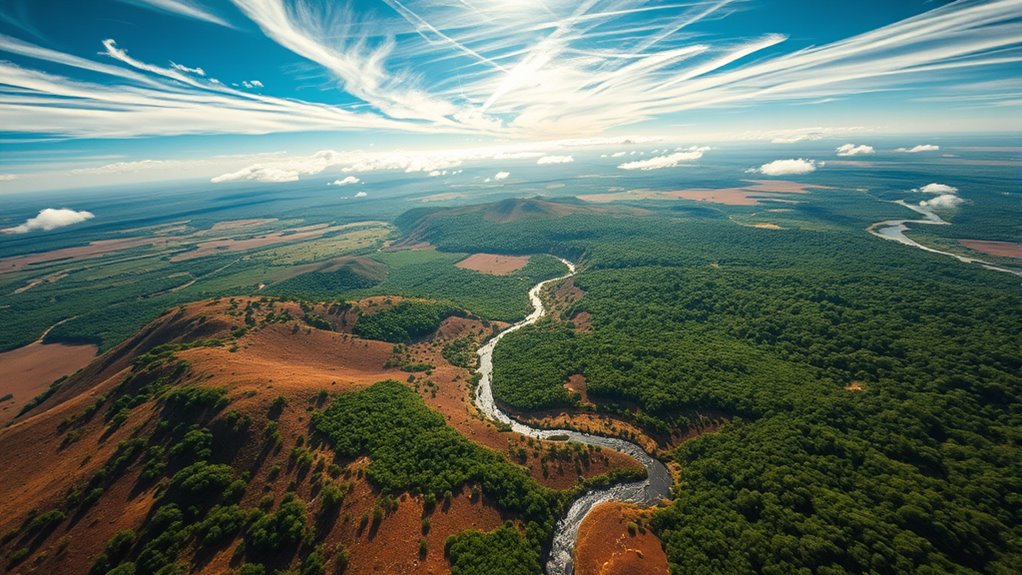
Have you ever looked up at the sky and wondered what it could reveal about your surroundings? By observing atmospheric conditions, you can gauge moisture levels that may lead to water sources.
High humidity often reduces visibility, making celestial observations less clear, while certain cloud formations can indicate impending rain. If you spot morning fog or dew, that's a sign of moisture you might collect.
Clear skies signal low humidity, providing better visibility of stars and planets, which helps assess the atmosphere. Remember, areas with minimal light pollution give you clearer views, helping you detect moisture more effectively.
Use these sky observations as a guide to navigate your search for water in the wilderness.
Collecting Rainwater Effectively
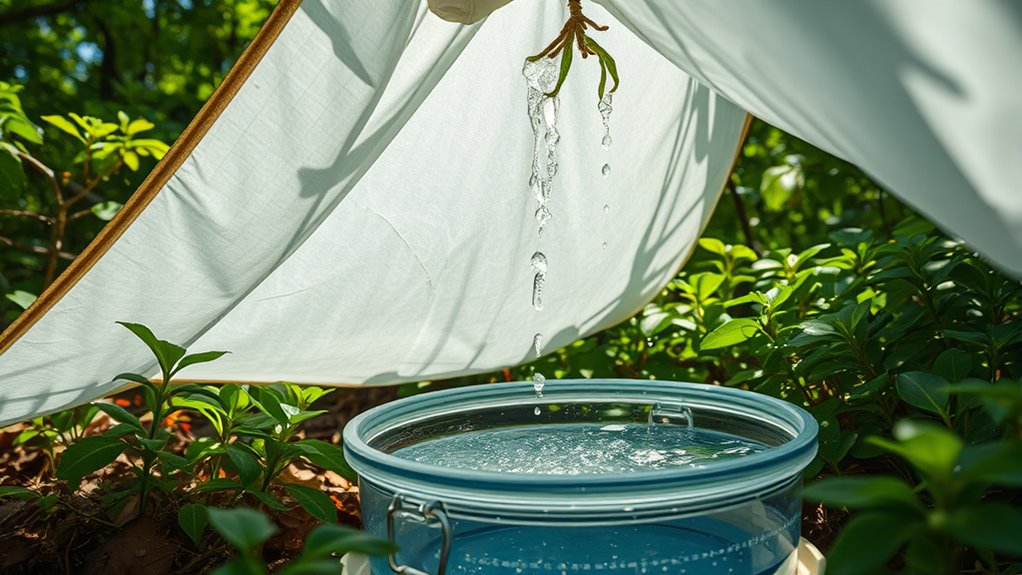
While exploring the wilderness, you can effectively collect rainwater to meet your hydration needs. Use a tarp to create a central depression, capturing runoff during rainstorms.
Collecting rainwater with a tarp in the wilderness is an efficient way to stay hydrated during your adventures.
Alternatively, if you have access to a roof, set up a simple collection system with gutters directing water into storage tanks. Ensure these tanks are kept out of sunlight to prevent algae growth.
Regularly maintain your system by filtering out debris and monitoring water quality. If excess water accumulates, consider using overflow pipes to redirect it to wildlife troughs.
Engaging with local communities can also enhance your collection projects, fostering a shared understanding of sustainable water practices.
Harvesting Melted Snow and Ice
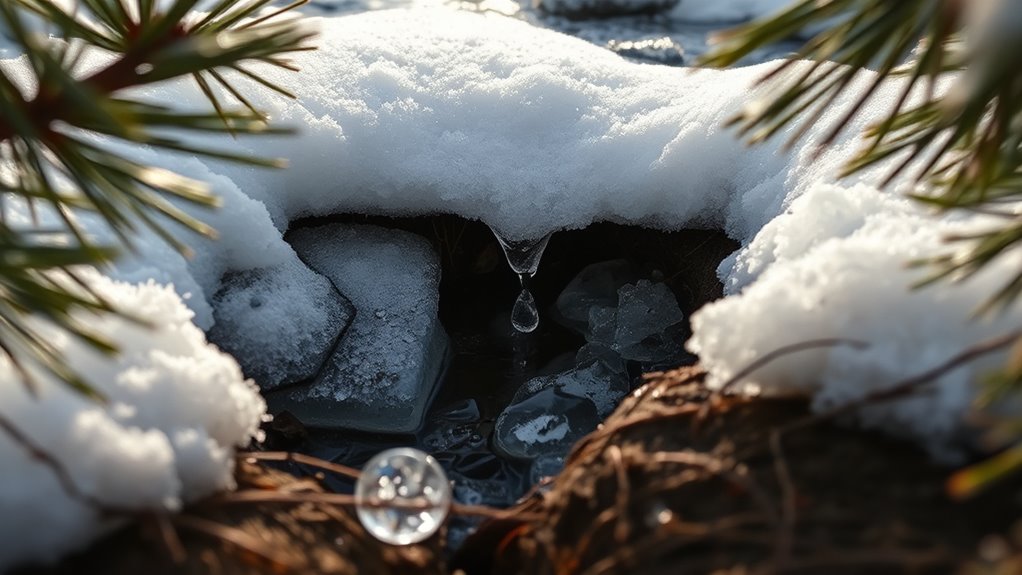
When temperatures drop and snow blankets your surroundings, knowing how to harvest melted snow and ice can be a lifesaver for your hydration needs.
Start by collecting snow from clean areas, scraping the top inch to remove debris. Opt for dense, old snow, as it yields more water than new powder.
Use aluminum or titanium pots for melting; they conduct heat well. Pour a bit of water into the pot before adding snow to speed up melting. Keep the pot level and cover it with a metal lid to retain heat.
If you're without equipment, create a V-Vessel from a split log to melt snow over a fire. This method provides continuous water collection with minimal effort.
Trapping Condensation From Plants

Trapping condensation from plants can be a smart way to collect water in the wild, especially on sunny days.
Start by selecting plants with large, green leaves or berry bushes, as they release more water vapor through transpiration. Use clear plastic bags to enclose leafy branches, ensuring part of the bag hangs lower to collect moisture. Secure the bags tightly with string and consider using multiple bags to increase your water yield.
After about 30-60 minutes, you'll notice condensation forming. Within 3-4 hours, expect at least 1/3 cup of water per bag.
Always verify the plants are non-toxic, filter the collected water, and keep your setup clean for safety.
Digging Wells in Promising Locations
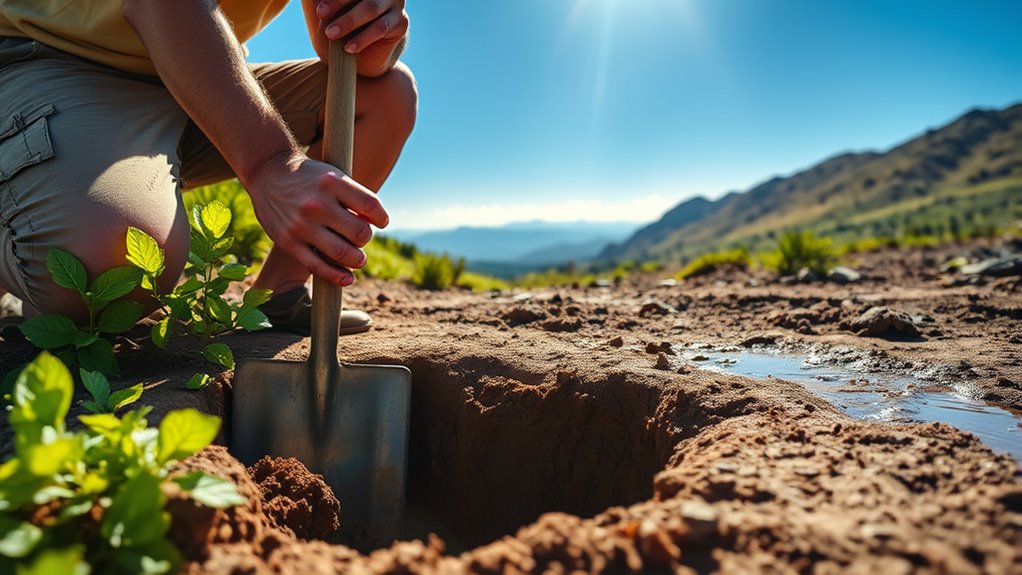
Finding a suitable spot for digging a well can significantly increase your chances of accessing water in the wilderness.
Look for geological features like valleys and gullies, which often indicate natural water collection. Pay attention to vegetation; plants such as willow and alder thrive in moist areas, suggesting nearby water.
Following animal tracks can also lead you to water sources, as animals regularly visit these spots. Choose low-lying areas with damp ground for the best results.
Before you start digging, clear any debris and assess the soil conditions. Mark the well's boundaries to ensure safety and protect wildlife by providing escape routes.
With careful preparation, you'll improve your chances of uncovering a reliable water source.
Constructing Solar Stills for Water Distillation
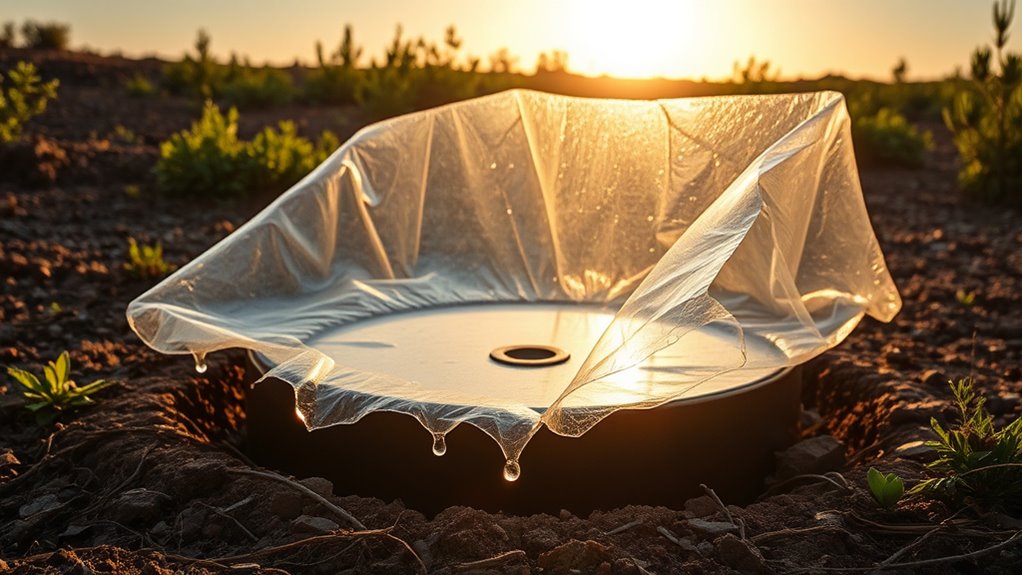
Constructing solar stills can be a lifesaver in the wilderness, especially when you're in desperate need of clean water. These simple devices use sunlight to evaporate water from contaminated sources and condense it for drinking.
Start by selecting a flat area with potential moisture, then dig a hole about 2-4 feet wide and 1-3 feet deep. Place a collection container in the center and add vegetation to boost moisture yield.
Cover the hole with a clear plastic sheet, sealing the edges tightly. As the sun heats the water, it evaporates, condenses on the plastic, and drips into your container. A well-built still can produce about a quart of water daily, making it an invaluable tool in survival situations.
Frequently Asked Questions
How Can I Purify Water From Natural Sources?
To purify water from natural sources, you can start by boiling it, which effectively kills harmful bacteria and pathogens.
If boiling isn't an option, use purification tablets or iodine for disinfection. You can also try solar disinfection by placing clear containers of water in sunlight for several hours.
For a simpler method, allow the water to settle, then carefully collect the clearer water from the top.
Always ensure it's safe before drinking.
What Tools Are Essential for Finding Water in the Wilderness?
To find water in the wilderness, you'll need essential tools like a digging tool for accessing underground sources and a container for collecting it.
Clear plastic sheeting helps you gather rainwater, while rocks can secure your setup.
A map and compass guide you to potential water areas, and binoculars let you spot signs of moisture from afar.
Don't forget a water purification method to ensure what you find is safe to drink!
How Do Weather Conditions Affect Water Source Availability?
You step into the wilderness, but wait—where's the water?
Weather conditions can drastically affect your water source availability. Droughts dry up rivers, while heavy rains can flood and contaminate what little remains. Freezing temperatures might lock away water, making it inaccessible.
You need to adapt quickly; understanding these fluctuations is crucial. If you're not prepared, you could find yourself in a dire situation, scrambling to locate safe drinking water.
Stay alert and plan ahead!
Can I Drink Water Directly From Rivers or Lakes?
You can't drink water directly from rivers or lakes without risking your health.
These sources often contain harmful microorganisms, chemicals, and pollutants. Even if the water looks clear, it might be contaminated.
Instead, always purify the water before drinking. Boiling, using filters, or chemical disinfectants are effective methods to ensure your safety.
What Signs Indicate a Reliable Water Source?
Did you know that about 60% of your body is made up of water?
To find a reliable water source, look for signs of lush vegetation, which often indicates moisture nearby.
Animal tracks can lead you to water, as many creatures need it daily.
Listen for the sound of running water, and check for wet soil or mud, as these can signal underground sources.
Always stay aware of your surroundings to ensure a safe find.
Conclusion
Finding water in the wilderness might seem daunting, but with the right techniques, you can tap into nature's hidden resources. Don't worry if you've never done this before; even beginners can succeed by paying attention to the signs around them. By understanding topography, observing wildlife, and using simple methods, you'll boost your chances of staying hydrated. So, grab your gear and venture out—you'll be surprised at how resourceful you can be when you need it most!


